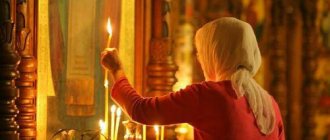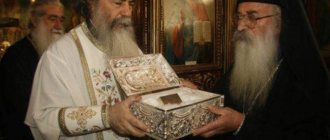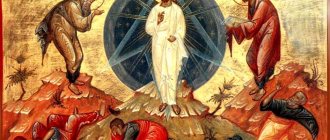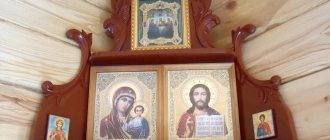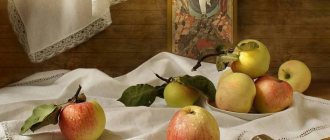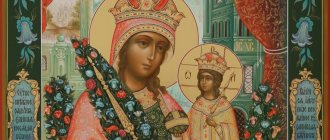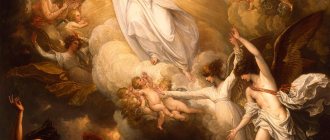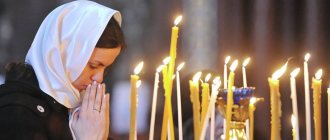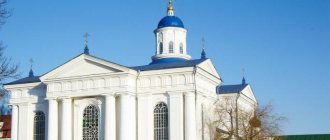The icon depicts the event of the Transfiguration of the Lord on Mount Tabor (Matthew 17:1-8; Luke 9:28-36). Transfiguration is a celebration of the Divine glory of Christ. In the Orthodox tradition, the Day of the Transfiguration of the Lord (August 19) is one of the 12 great holidays, which are of such significance that they completely replace the texts even for Sunday services.
Story
The ascent of Mount Tabor occurred at the most critical moment in the Lord's service, as he embarked on his final journey to Jerusalem, which he knew would end in humiliation and death.
The Feast of the Transfiguration is not just a reminder of an event that occurred in the life of Christ. It also contains an “eschatological” dimension, aimed at the future - to the glory of the Kingdom of God, which all Christians expect to see.
Everything was illuminated and touched by the glory of heaven that came from Jesus: the grass, the mountains and their peaks, animals, birds and insects and the disciples of Christ - Peter, James and John. What the apostles saw on the mountain was, according to the explanation of the Church Fathers, a foreshadowing of the future world after the resurrection from the dead, a vision of a transfigured world that had reached its utmost perfection.
The apostles, who saw the Transfiguration of the Lord, gradually carried out this transformation throughout their lives. They transformed society. They transformed those they met and took great pains to announce to them:
Jesus rose from the dead, Jesus turned death into life, Jesus turned strangers into pilgrims who know where they come from, where they are going and why.
Meaning
Along an imaginary horizontal axis, the icon is divided into two equal parts. The top half depicts the new perfect world represented by the glorified Jesus Christ and the prophets Elijah and Moses. While the lower part depicts our temporary earthly reality, represented by the disciples of Jesus - Peter, James and John.
In the center of the upper part is Jesus Christ, standing and blessing with both hands, dressed in a white robe. His tunic is white (a delicate light blue tone) and his coat is tinged with red (a subtle reddish or rather pinkish tone). These colors can symbolize the Divine as well as the human nature of Christ, because even in his glory he retained a human body.
On the right shoulder there is a stripe on the tunic - the clavus, a symbol of Jesus' royal dignity, emphasizing the power of his blessing. The serious, noble face of Christ, framed by long, dark, smooth, combed-back hair and a short beard, seems to be addressed to all humanity.
Christ is surrounded by a circular halo, the outer ring of which is dark brown, then, below, a light brown ring, and the inner part is formed by a deep orange-red circle with a scalloped edge that extends from the figure of Christ.
Thin golden rays diverge evenly and densely in all directions from the halo representing the Sun, the source of light, the symbol of Christ (Christ, the light of the world). Next to the round halo are the letters IC on the right and XC on the left, which are the initial and final letters of the name of Christ (IHCOC, XPECTOC) (Exodus 3:14).
The background of the icon has an orange tint. Orange is created by mixing red and brown. The red color in the background of the icon means the triumph of eternal life, and brown is the color of the earth and everything temporary. Thus, the orange background color can symbolize the victory of the eternal over the temporary.
To the right of Christ we see the prophet Elijah, barefoot, dressed in a dark blue-green tunic, with a dark purple himation (cloak) decorated with gilding.
He is depicted as an older man, with long, graying, slightly curly, combed-back hair and a long beard. His serious face with beautiful features is turned to the Lord. In his left hand he holds a scroll, and with his right he points to the Lord.
To the left of Christ stands the prophet Moses (Holy Prophet Moses), his face turned to the Lord.
He is depicted as a middle-aged man with a high forehead, short curly dark brown hair and a short beard. He is dressed in a long dark blue tunic, on which is a bright red himation decorated with gilding. He holds a book in his hands.
The gilding of the robes of both saints means that they are already glorified. All three characters stand on hills that are different shades of brown.
A massive beam of golden rays shines from the figure of Christ, it is tinted bright red, branching into three beams, each pointing to one of the three apostles depicted at the bottom of the icon, on Earth, in a predominantly grassy area, dark green, sometimes interrupted by various shades brown. These are both real and symbolic colors of the earthly world. The color green here refers to the Holy Spirit, who is everywhere and illuminates everything.
On the right is the Apostle Peter kneeling facing the Lord. He extends his left hand towards it, surprised by the unexpected revelation he is witnessing. He has short curly gray hair and a short curly beard. He is dressed in a dark blue tunic and a walnut-brown himation, decorated with gilding.
Jesus' two other disciples had just woken up; they had been sleeping because they were tired. In the center is the Apostle John, kneeling with his arms outstretched and his head bowed, depicted as a young man with a gentle face, no beard and long dark brown curly hair. His clothes are a dark green chiton and a dark red himation, decorated with gilding.
On the left lies the Apostle James, his face turned down and his gaze directed forward. He has short curly brown hair and a short beard, a red tunic decorated with gold and a dark blue-green himation. The gilding of the apostles symbolizes that the reflection of the glory of Christ falls on them.
From the festive ceremony
- Lazarev 1980: 1405
- Popov 2007/1: 1410–1420s
| Details | |||
| [A] Elijah the Prophet | [A1] Elijah the Prophet | [B] Moses | [B1] Moses |
| [C] Half-figure of the Apostle Peter | [D] Christ and the prophets Elijah and Moses | [E] Apostle John | [F] Apostle James |
| [G] Apostle Peter | [G1] Apostle Peter | [H] Half-figure of the prophet Moses | |
- Lazarev 1966/1.
[94] Lazarev V.N. Andrei Rublev and his school. - M.: Art, 1966. - Page. 19-20, 96-97, 112-113, tab. IV, 14-18. [see: pp. 19-20, pp. 96-97, pp. 112-113] - Alpatov 1967.
[120] Alpatov M. V. Sketches on the history of Russian art. In 2 volumes. - M.: Art, 1967. - T.1, pp. 127-137, ill. 92, 93, 95, 97, 98. - Alpatov 1972.
[320] Alpatov M. V. Andrey Rublev. - M.: Fine Arts, 1972. - Page. 32, tab. 3-7. - Alpatov 1974.
[4] Alpatov M.V. Paints of Old Russian icon painting = Color in Early Russian Icon Painting. - M.: Fine Arts, 1974. - No. 27. - Alpatov 1978.
[89] Alpatov M.V. Old Russian icon painting = Early Russian Icon Painting. - M.: Art, 1978. - No. 79, p. 305. - Lazarev 1980.
[1] Lazarev V.N. Moscow school of icon painting = Les icôn de l'école de Moscou. - M.: Art, 1980. - Page. 18, no. 25. - Kachalova, Mayasova, Shchennikova 1990.
[53] Kachalova I. Ya., Mayasova N. A., Shchennikova L. A. Annunciation Cathedral of the Moscow Kremlin: To the 500th anniversary of a unique monument of Russian culture. - M.: Art, 1990. - Page. 56-59, 77, nos. 136, 137. - Lazarev 2000/1.
[9] Lazarev V.N. Russian icon painting from its origins to the beginning of the 16th century. - M.: Art, 2000. - Page. 98, 365, no. 96. - Popov 2002R.
[38] Popov G.V. Andrey Rublev. - M.: Art-Rodnik, 2002. - Ill. 50. - Shchennikova 2004.
[199] Shchennikova L. A. Icons in the Annunciation Cathedral of the Moscow Kremlin. Deesis and festive rows of the iconostasis: Catalog. - M.: Red Square, 2004. - Cat. No. 18, pp. 206-211. - Popov 2007/1.
[688] Popov G.V. Andrei Rublev = Andrei Rubliov. - M.: Northern Pilgrim, 2007. - Ill. 139, 141.
Source of the article: https://www.icon-art.info/masterpiece.php?lng=ru&mst_id=126
Iconography
The formation of traditional Orthodox iconography of the Transfiguration of the Lord was completed by the 9th century. On the icons, Christ is depicted on the top of a rock, but stands not on, but above it - as if floating in the air. On either side of Him, also in the air, stand Moses and Elijah. And under the rock the apostles are depicted in very expressive poses - they covered their faces and lie on the ground, not daring to look towards the Teacher, from whom a dazzlingly bright unearthly light emanates.
Monastery of St. Catherine in Sinai
The earliest surviving image of the transfiguration is from the Monastery of St. Catherine in Sinai, where, due to its seclusion, many early icons are located. In the apse of the temple there is a mosaic of the Transfiguration of the Lord, dating from the mid-6th century.
Monastery of St. Catherine, Sinai
Christ is the center and focus of the image, his hand in blessing, his eyes directed towards us. His clothing is depicted as “white as light,” as described by the Gospel writers. The glory of God overshadowing the scene is shown by the mandorla around Jesus. Rays of light are visible from his body, striking each of the five present: to the right of Christ is the prophet Elijah; on the left is Moses; at his feet are the apostles John, Peter and James.
Moses captures the drama of the event: the three apostles have dismayed expressions on their faces, while Christ stands calmly in the center above them, flanked by Moses and Elijah, who appear to bless him. All subsequent icons of the Transfiguration differ little from this basic composition.
Monastery of Daphne
Mosaic in Daphne Monastery, Haidari
The mountain on which the Transfiguration took place was named Mount Tabor by Saint Jerome. The mountain plays an important role in Divine Revelation as described in the scriptures and connects Moses and Elijah who are miraculously present next to Christ.
Moses ascended Mount Sinai to receive the Ten Commandments and converse with God in the Great Cloud of Divine Glory. Elijah was told to go up Mount Horeb (probably an alternative name for Sinai), where he heard the voice of God in the “gentle wind.”
In the biblical narrative, as in the icons, these two interlocutors with God are now shown in conversation with Christ Himself, which is a clear indication of the divinity of Jesus.
Later, the icons show Moses holding a book - the Torah. Elijah, dressed in animal skins and resembling John the Baptist, represents the prophets, while Moses represents the law. Jesus Christ is the fulfillment of both.
Icon of Theophanes the Greek
Theophanes the Greek (c. 1340-c. 1410) was one of the greatest icon painters of Muscovite Rus' and was known as the teacher and mentor of the great Andrei Rublev. He moved from Constantinople to Novgorod in 1370, and from there to Moscow in 1395.
Feofan's contemporaries in Moscow described him as a "scholar in philosophy." He achieved that he transferred the teaching of the holy fathers about the Transfiguration into his own icon.
Icon of Theophanes the Greek (late 14th century)
The geometry of the image emphasizes the serenity of Christ compared to the disorder of the apostles: Peter extends his hand, as if in the middle of a sentence: “Lord, it is good for us to be here...” (Mt 17:4)
The bold icon of Theophanes is divided in two: Christ and the apostles on Mount Tabor, with Moses and Elijah removed to separate but adjacent peaks.
Theophanes was not the first icon painter to do this: Mount Tabor and Mount Sinai/Horev are different, and so it was customary to depict Moses and Elijah standing on different peaks, leaning toward Christ.
Theophan emphasizes the difference between the two Old Testament saints, on the one hand, and the apostles of Christ, on the other. Through three rays of light he draws the three apostles and us to the dazzling light that surrounds Jesus.
Thus, Theophanes presents to us the already ancient teaching that the transformation was not only an event that we witnessed, but also a process in which we ourselves had to participate.
Moldavian icon
In the Gospels, the transfiguration occurs just six days after Christ's long narrative about the End of the World, the Last Judgment, and the Second Coming of Christ. Christ ends his words with a promise:
There are some standing here who will not taste death until they see the Son of Man coming in His kingdom.
The Transfiguration, then, is the fulfillment of the promise of Jesus, and therefore what the apostles experience is a foretaste of the future life - “the power and coming of our Lord Jesus Christ,” according to the Apostle Peter.
The icon of Theophanes, perhaps for the first time, shows the ascent and descent from Mount Tabor. This is an important part of the event: Christ was not suddenly transformed among his disciples while preaching in Galilee. Instead, Christ chose three of his disciples, led them to a mountain to pray, and there they saw the future glory of God in the present.
Moldavian icon, 16th century (now in Bucharest)
However, after the ascent, the descent began. No one can experience such divine glory for a long time in this life: it is a promise of a future life. The image on the icon is an experience for all of us. The geometry of Theophanes's icon, which draws us into this scene, does so not so that we can observe it, but so that we can experience it.
We too must climb the spiritual mountain. And at the top, in prayer, these rays of Divine light can penetrate into us.
Icon in Rybinsk
Later icons show the apostles in the same "orderly disorder" of the first Sinai mosaic, but their facial expressions have changed from fearful to sleepy.
Rybinsk State Historical and Architectural Museum (early 19th century)
This follows from Luke's account, where he describes the apostles awakening from a heavy sleep to witness the Transfiguration. It is this fatigue that explains their inability to understand the significance of the event and the conversation between Christ and the Old Testament saints about his future crucifixion.
This is also a lesson: along with spiritual harmony and prayer, vigilance is necessary. When Elijah heard God on Mount Horeb, it was not in a roaring wind, earthquake, or fire, but in stunning silence.
What would he have heard if he had not been paying attention? What can we get from God if we are not careful?
Prayer
Lord Jesus Christ, our God, in the Living Light, unapproachable, the Radiance of the Father’s Glory and the Image of His Hypostasis!
When the fulfillment of times came, You humbled Yourself for your unspeakable mercy for the fallen human race, You took on the form of a servant, You humbled Yourself, obedient even to the point of death.
Moreover, before the Cross and Your free passion on Mount Tavorstei, You were transfigured in Your Divine Glory before Your saints, the disciples and Apostles, little hiding the perception of the flesh, so that when they see You crucified and put to death, they will understand Your free suffering and Divinity.
Grant to all of us, Thy most pure Flesh, the Transfiguration of those celebrating, with pure hearts and undefiled minds, to ascend to Thy Holy Mountain, to the holy villages of Thy glory, where the pure voice of those celebrating, the voice of unspeakable joy, so that together with them, face to face, we will see Thy Glory in unfading are the days of Your Kingdom, and with all the saints who have pleased You from all eternity, let us glorify Your All-Holy Name with Your Originless Father and Your Most Holy and Good and Life-Giving Spirit, now and ever and unto the ages of ages.
Anyone who stands before the icon of the Transfiguration of the Lord with an open heart receives an impulse to transform from an “old” person into a “new” one.
How does the Transfiguration of the Lord icon help?
To celebrate the Transfiguration of the Lord, a solemn liturgy is held, and prayers are offered before the icon for forgiveness of sins and cleansing.
It really helps to cleanse the soul of bad, sinful thoughts and strengthen faith.
Believers not only ask the Lord for help and protection for themselves and loved ones, but also offer him gratitude and praise.
In folk tradition, the Transfiguration of the Lord is also called the Second (Apple) Savior, when the fruits of the new harvest are blessed in churches. On this day, people are supposed to visit the graves of their ancestors and leave apples on them, as well as distribute them to those in need.
